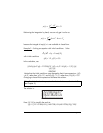
Page 16-17
Applications of Laplace transform in the solution of linear ODEs
At the beginning of the section on Laplace transforms we indicated that you
could use these transforms to convert a linear ODE in the time domain into an
algebraic equation in the image domain. The resulting equation is then solved
for a function F(s) through algebraic methods, and the solution to the ODE is
found by using the inverse Laplace transform on F(s).
The theorems on derivatives of a function, i.e.,
L{df/dt} = s⋅F(s) - f
o
,
L{d
2
f/dt
2
} = s
2
⋅F(s) - s⋅f
o
– (df/dt)
o
,
and, in general,
L{d
n
f/dt
n
} = s
n
⋅F(s) – s
n-1
⋅f
o
−…– s⋅f
(n-2)
o
– f
(n-1)
o
,
are particularly useful in transforming an ODE into an algebraic equation.
Example
1 – To solve the first order equation,
dh/dt + k⋅h(t) = a⋅e
–t
,
by using Laplace transforms, we can write:
L{dh/dt + k⋅h(t)} = L{a⋅e
–t
},
L{dh/dt} + k⋅L{h(t)} = a⋅L{e
–t
}.
With H(s) = L{h(t)}, and L{dh/dt} = s⋅H(s) - h
o
, where h
o
= h(0), the transformed
equation is s⋅H(s)-h
o
+k⋅H(s) = a/(s+1).
Use the calculator to solve for H(s), by writing:
‘X*H-h0+k*H=a/(X+1)’ ` ‘H’ ISOL
Note: ‘EXP(-X)’ ` LAP , produces ‘1/(X+1)’, i.e., L{e
–t
}=1/(s+1).


















